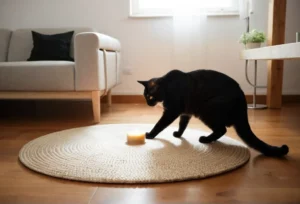Intro: Cats are fascinating creatures with unique characteristics, one of which is their thick claws. Have you ever wondered why cats’ claws get thick? Let’s explore the reasons behind this intriguing phenomenon.
Evolutionary Purpose of Thick Cat Claws
Have you ever wondered why your furry feline friend has such thick claws? Well, it all comes down to evolution! In the wild, cats need those sharp claws to hunt for food, defend themselves against predators, and establish territory. Over time, cats have developed thicker claws to better adapt to their environment and increase their chances of survival.
One unique insight into this evolutionary process is the cat’s need to maintain their claws for grooming and marking territory. Thick claws allow cats to easily groom themselves by removing dead layers of claw, keeping them sharp and healthy. Additionally, thicker claws provide more stability and traction when climbing trees or defending themselves, ultimately enhancing their chances of survival in the wild.
Overall, the evolutionary purpose of thick cat claws is closely tied to their instinctual need for survival, whether it’s hunting for prey or facing off against rivals. These claws are not just a handy tool for cats, but a crucial adaptation that has been honed over thousands of years to ensure their continued success in the wild.
Factors Contributing to Claw Thickness
When it comes to the thickness of your cat’s claws, there are several factors at play. Age, health, and activity level all play a role in determining the thickness of a cat’s claws. Younger cats tend to have thinner, sharper claws, which gradually thicken as they age and become less active.
Furthermore, a cat’s overall health can also impact the thickness of their claws. Poor nutrition or underlying health issues can lead to brittle claws that are more prone to breaking or splitting. On the other hand, a healthy diet and regular exercise can help maintain strong and thick claws for your feline friend.
It’s essential to consider your cat’s individual needs and provide adequate care to ensure their claws remain healthy and functional. Regular nail trimming and providing appropriate scratching posts can help keep their claws in top shape, regardless of their thickness. Remember, a healthy cat is a happy cat with claws that are ready for any adventure that comes their way!
Importance of Regular Claw Maintenance
Regular claw maintenance is essential for your cat’s overall health and well-being. When cats’ claws become thick, it can lead to discomfort and even health issues. By trimming your cat’s claws regularly, you can prevent them from becoming too thick, which can cause pain and difficulty walking or grooming. Additionally, keeping your cat’s claws at a healthy length can also minimize the chances of them getting caught on furniture or carpets, reducing the risk of injury.
It is recommended to establish a routine for claw maintenance, whether you choose to trim your cat’s claws yourself or seek the assistance of a professional groomer or veterinarian. By staying consistent with claw care, you can help your cat maintain optimal claw health and overall well-being.
Behavioral Implications of Thick Claws
Thick claws can have behavioral implications for cats, impacting their ability to climb, scratch, and groom properly. Cats with thick claws may experience discomfort or difficulty engaging in their natural behaviors, leading to frustration or behavioral changes. Owners may notice their cat scratching more aggressively or avoiding certain activities due to the discomfort caused by thick claws.
To address behavioral issues related to thick claws, it is important to regularly trim your cat’s claws to maintain a healthy length. Providing appropriate scratching posts and toys can also help keep your cat’s claws in good condition and prevent them from becoming overly thick. By addressing thick claws proactively, you can help your cat lead a happier and more comfortable life.
Tips for Maintaining Healthy Cat Claws:
- Provide scratching posts: Offer multiple scratching posts throughout your home to encourage your cat to scratch in appropriate areas.
- Regular grooming: Brush your cat regularly to remove loose fur and dirt, which can contribute to thickening of the claws.
- Consult a professional: If you are unsure how to trim your cat’s claws safely, seek guidance from a veterinarian or professional groomer.
- Monitor claw length: Keep an eye on your cat’s claws and trim them as needed to maintain a healthy length.
By following these tips and staying proactive about your cat’s claw health, you can help prevent thick claws and ensure your feline friend stays happy and healthy.
Health Issues Related to Thick Claws
Thick claws in cats can pose various health issues if left untreated. One common problem is ingrown claws, where the nail grows into the paw pad, causing pain and potential infection. To prevent this, regularly trim your cat’s claws or seek professional grooming services. Another issue is the accumulation of dirt and bacteria under thick claws, leading to infections. Keep your cat’s claws clean by gently wiping them with a damp cloth or special pet wipes.
Unique insight: Cats with thick claws may also be at higher risk of causing accidental scratches or injuries to themselves or their owners. Keeping their claws trimmed can help reduce this risk and maintain a safe environment for everyone.
Differences in Claws Between Breeds
Different cat breeds can exhibit variations in the thickness of their claws. For example, breeds like Maine Coons and British Shorthairs tend to have thicker and more robust claws compared to more delicate breeds like Siamese or Bengals. Understanding these differences is crucial for tailoring your cat’s grooming routine. Thicker claws may require more frequent trimming to prevent overgrowth and potential health issues.
- American Shorthair: Bold and playful breed with moderate claw thickness. Regular trimming is recommended.
- Persian: Known for their luxurious fur, Persians have slightly thicker claws that may require extra care during grooming.
- Siamese: Sleek and slender breed with delicate claws that are prone to breaking. Gentle handling during grooming is essential.
Remember, regardless of your cat’s breed, regular claw maintenance is key to keeping them healthy and happy. Consult your veterinarian or a professional groomer for guidance on the best grooming practices for your feline friend.
Trivia: Fun Facts About Cat Claws
Did you know that a cat’s claws are retractable, allowing them to extend or retract whenever needed? This unique feature helps protect the claws and keep them sharp for various tasks.
Contrary to popular belief, a cat’s claws are not actually sharpened by scratching on surfaces. Instead, cats scratch to remove the outer sheath of the claws, revealing the new, sharper claw underneath.
Another interesting fact is that a cat’s claws are connected to the bones in their toes, giving them incredible control and precision when climbing, scratching, or hunting.
Tips for Maintaining Healthy Claws
To prevent your cat’s claws from becoming excessively thick, provide them with appropriate scratching posts or pads made of rough material like sisal or cardboard. Encouraging natural scratching behavior can help keep their claws healthy and trimmed.
Regular nail trims are essential for maintaining healthy claws. If you’re unsure how to do this, consider seeking guidance from your veterinarian or a professional groomer to avoid injury.
Ensure your cat has a balanced diet rich in essential nutrients like protein and biotin, which contribute to healthy nail growth. Hydration is also crucial, so always provide fresh water for your feline friend.
Bonus Tip: Regular playtime that involves climbing and scratching can help naturally wear down your cat’s claws, promoting overall claw health.
Remember, healthy claws are essential for your cat’s well-being and natural behaviors, so incorporating these tips into their routine can benefit them greatly.
The Role of Diet in Claw Health
The health of a cat’s claws is closely linked to its diet. A balanced diet rich in essential nutrients plays a crucial role in maintaining optimal claw condition. Foods high in protein, such as meat, are essential for healthy claws as they provide the building blocks necessary for strong and resilient claws. Additionally, omega-3 fatty acids found in fish can help reduce inflammation and promote healthy claw growth.
Furthermore, adequate hydration is key for maintaining healthy claws. Make sure your feline friend has access to fresh water at all times to support claw health from within. Avoid feeding your cat unhealthy snacks or excessive treats, as these can lead to nutritional deficiencies that may manifest in thickened claws.
By providing your cat with a well-rounded, nutritious diet, you can help ensure that their claws stay in top shape. Remember, your cat’s diet plays a significant role in their overall health, including the condition of their claws.
Regular Claw Maintenance
In addition to diet, regular claw maintenance is crucial for ensuring your cat’s claws stay healthy. Providing scratching posts or pads can help your cat keep their claws in good condition by promoting natural scratching behavior. Trimming your cat’s claws regularly can also prevent them from becoming overly thick or sharp.
When trimming your cat’s claws, be sure to use proper tools designed for this purpose to avoid injuring your furry friend. If you’re unsure how to trim your cat’s claws safely, consider consulting a veterinarian or a professional groomer for guidance. Regular maintenance can help prevent thickening of the claws and promote overall claw health.
Remember, proactive care is key to keeping your cat’s claws in top condition.
Additional Tip: Offering your cat a variety of textures to scratch on can also help maintain healthy claws. Different textures can help wear down the claws naturally, preventing them from becoming overly thick.
Alex, a passionate animal lover, has experience in training and understanding animal behavior. As a proud pet parent to two dogs and three cats, he founded AnimalReport.net to share insights from animal experts and expand his knowledge of the animal kingdom.




